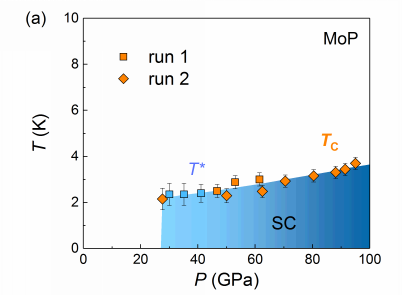Chinese scientists have discovered a new material that can conduct electricity with zero resistance, or superconduct upon heavy compression.
In the research, scientists took a close look at molybdenum phosphide (MoP), a newly identified triply degenerate fermions material via application of external pressure.
This discovery was made by a joint team from Institute of Solid State Physics and High Magnetic Field Laboratory of Hefei Institutes of Physical Science.
Pressure is a viable physical tuning parameter which can induce superconductivity in the materials that would not superconduct if not pressurized.
Here, the researchers applied pressure to MoP using a diamond anvil cell (DAC), a device that uses the polished facets of two diamonds, the hardest materials in nature, to squeeze a sample placed between them.
They measured the temperature-dependent resistivity to characterize the superconductivity.
The results show that superconductivity emerges in MoP with an onset critical temperature Tc of ca. 2.5 K at ca. 30 GPa. Upon further increasing the pressure, Tc was enhanced to 4 K at 95 GPa.
To track the structural changes at high pressure, the researchers used synchrotron-based x-ray diffraction (XRD) at the Advanced Photon Source of Argonne National Laboratory. No structural phase transition was observed in MoP up to 60 GPa.
Through density functional theory (DFT) calculations, the researchers predicted that the pressure-induced superconductivity and nontrivial band topology coexist in MoP at pressures between 30 and 60 GPa.
The breakthrough represents a promising strategy to access topological superconductor which host Majorana fermion―the qubit for high fault-tolerant quantum computation.
The research, led by Prof. YANG Zhaorong at Hefei Institutes of Physical Science was recently published with Dr. CHI Zhenhua as the first author in the nature partner journal npj quantum materials.
This investigation was supported by the National Key Research and Development Program of China and the National Natural Science Foundation of China. (十日内)
Link to the paper: Pressure-induced superconductivity in MoP

Figure 1. Micrograph of sample in contact with four electrodes inside the DAC.
(Image by CHI Zhenhua)

Figure 2. Pressure-temperature phase diagram of MoP.
(Image by CHI Zhenhua)
Contact:
ZHOU Shu
Hefei Institutes of Physical Science (http://english.hf.cas.cn/)
Email: zhous@hfcas.ac.cn
 Tel: +86-551-65591206
Tel: +86-551-65591206
 Fax: +86-551-65591270
Fax: +86-551-65591270
 Emai: zhous@hfcas.ac.cn
Emai: zhous@hfcas.ac.cn
 350 Shushanhu Road
350 Shushanhu Road